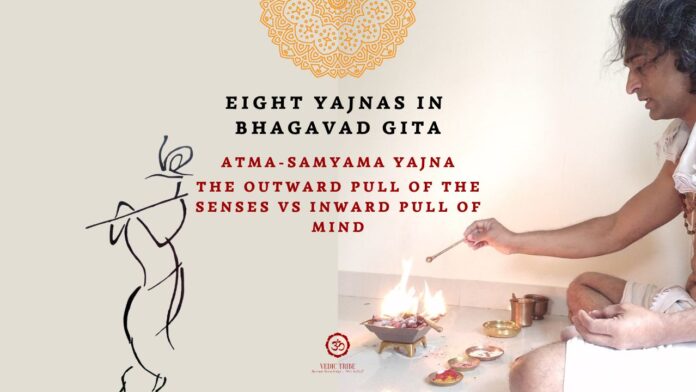The Outward Pull of the Senses vs inward pull of mind:
In the previous article, we discussed Samyama Yajna (yajna of regulation of senses) and in this article we will discuss Atma Samyama Yoga Yajna (yajna of regulation of mind).
Why regulation of mind is harder?
Regulation is mind is harder than regulation of senses because much of the mind’s activity is driven by subconscious patterns, beliefs, and emotional responses that we may not be consciously aware of.
The senses primarily deal with external stimuli. We can, to a degree, control what we see, hear, taste, smell, and touch. The mind, on the other hand, is an internal landscape of thoughts, emotions, memories, and desires. The mind is inherently restless and prone to wandering. Thoughts arise and disappear rapidly, making it difficult to maintain focus. While we have physical tools to control our senses, the tools for mind control are primarily internal: mindfulness, meditation, self-awareness.
The Challenge of Inward Focus:
Turning our mind inward requires a deliberate effort to shift our attention from external objects to internal experiences. This can be challenging for several reasons:
Mind Wandering: Our minds are naturally prone to wander, constantly seeking new stimuli.
Emotional Distractions: Emotions can cloud our judgment and make it difficult to maintain focus.
Habitual Patterns: We may have developed habits of sensory indulgence, making it difficult to break free from these patterns.
The Yajna of the Mind:
When we deliberately turn our mind inward, we are essentially undergoing a form of “withdrawal” from the constant stimulation of the external world. This can lead to a range of withdrawal symptoms, similar to those experienced when quitting an addictive substance.
We may experience – restlessness, anxiety, irritability, difficulty in concentrating, physical discomfort…etc. These are the moments we exercise our will-power and continue to deliberately keep the mind inward.
All the discomfort experienced are to be offered as oblation in the fire of mind in this Yajna called “Atma Samyama Yoga Yajna”.
Here is what you can do:
Oblation to almighty: Consider that your mind itself is an oblation to almighty in the fire of your soul and you are performing Atma Samyama Yoga Yajna
Meditation: Regular meditation practice can help train the mind to focus and reduce distractions. Offer this practice as oblation in the Yajna of Mind
Vipassana: Vipassana’s core practice is developing heightened awareness of bodily sensations.
This cultivates a deep understanding of how the mind and body are interconnected. This increased awareness is fundamental to Atma Samyama Yoga, which requires the ability to observe and control the mind’s tendencies
Yoga Nidra: A guided relaxation technique that can induce a state of deep relaxation and consciousness. Offer this practice also as oblation in the Yajna of Mind
Remember:
Mind wanders away: Lord Krishna repeatedly acknowledges that the mind is very difficult to tame. So, do not give up easily
Social resistance: Your friends and family might not appreciate your inward focus. Calmly explain your goal to them, irrespective of whether they accept your resolution or not
By consistently practicing these techniques, you can gradually strengthen our mental ability to turn inward and experience the profound benefits of inner peace and spiritual growth.
By integrating Atma Samyama Yoga Yajna into our daily lives, we can transform the most difficult process of regulation of our mind – into a spiritual practice.
In the next article, we will discuss the fourth yajna – “Dravya Yajna”.
Madhwesh K
Vedic Tribe

